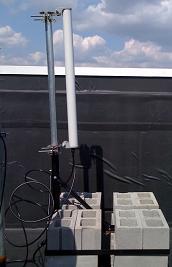| Version 15 (modified by , 14 years ago) (diff) |
|---|
7. Campus Installation
7.1 License
Person submitting application needs to obtain either personal or institution FCC Registration Number (FRN); if one is not available, it can be obtained through FCC's COmmission REgistration System (CORES) registration.
With FRN, applicant can start the application process by filling Form 442. Required information for filling up the form includes:
- Frequency: ??
- Frequency tolerance: 0.00002 %
- Power: 20 W
- Radius: 5 km
- Location: [please use Google Earth/Maps to find out latitude/longitude of the location where you plan to install the antenna]
- Emission designator: W7D
- Contracting Agency: National Science Foundation
- Contract Number: 0944089
It should be noted that this license (experimental authorization) "is to be used for fulfilling the requirements of a U.S. government contract".
Each application should attach a project overview, including details of NSF contract (award) in the filing process since this increase the likelihood of license issuance and will expedite the process.
At the end of the application process, the applicant must pay the $60 application fee; the fastest method of payment is by credit card. NOTE: FCC has a site for testing the application process.
Once application process is completed and assuming there are no issues with the particular location, after 4-8 weeks FCC will issue WIMAX license.
Here is WINLAB Rutgers WiMAX license received from the FCC.
7.2 Antenna
 The base station kit includes one dual-polarization, omnidirectional antenna.
The base station kit includes one dual-polarization, omnidirectional antenna.
Since throughput and coverage of WiMAX systems are highly influenced by the antenna location, care should be taken that the antenna is mounted so that siginificant portion of First Fresnel Zone is clear of obstructions. Ideally the antenna is mounted on the elevated structure providing clear line of sight to most of the intended coverage area.
The installation should be performed by qualified PE to ensure proper grounding and should follow NEC's mounting instructions.
7.3 Base Station Outdoor and Indoor Units
The Outdoor Unit (ODU) is mounted outdoors, near the antenna. It connects to the antenna with a coaxial cable, and connects to the Indoor Unit (IDU) with two fibers. In addition, it requires a -48 power feed and a protection ground.
The Indoor Unit (IDU) is mounted indoors, typically in an equipment room. It connects to the ODU with two fibers, and to the Linux servers usxing an ethernet cable. In addition, it requires a -48 power feed and a protection ground.
The installation should be performed by qualified PE to ensure proper grounding and should follow NEC's installation instructions
7.4 Linux Server(s) and Software
7.5 Backbone Network Connectivity
7.6 Reference Client Platform
7.7 Inital Check-Out
Attachments (5)
-
ANTENNA.pdf (643.8 KB) - added by 14 years ago.
WiMAX Antenna Installation Manual
-
BS_INSTALLATION.pdf (3.0 MB) - added by 14 years ago.
WiMAX Base Station Installation Manual
-
Antenna.jpg (8.9 KB) - added by 14 years ago.
Non-Penetrating Roof Antenna Mounting Example
-
Winlab-WiMax-License.pdf (15.4 KB) - added by 14 years ago.
WiMAX Experimental License
- 113009 v0.5 GENIDandPInfraBuildouts.pdf (181.1 KB) - added by 14 years ago.
